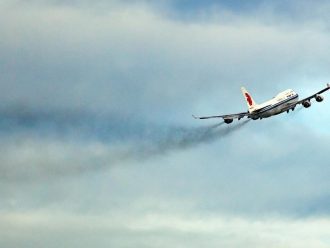Contributing writer for Wake Up World
As someone who lives to travel, the reality of jet transportation and the severe effect it has on the planet is never far from my mind. Over the years, I’ve curbed my wanderlust and have stayed rooted for increasingly longer stretches of time. I’ve even fantasized about true eco-friendly modes of travel, like long-distance biking highways free of cars, wind-powered cruise ships and high-tech trains that run on alternative energy.
While I doubt we’ll be seeing any of these innovations any time soon — the infrastructure would be expensive to build and unlikely to be made a priority in our car-obsessed culture — something that could become a reality in the not-so-distant future is significant improvements in aviation technology, which dramatically lower airplane fuel consumption and pollution.
The Environmental Cost of Aviation
After reading the statistics on the environmental impact of jet travel, I’ve seriously considered ditching it altogether, packing my young daughter into a bike trailer and setting off on a long-distance bicycle ride from Montana, United States down to our new home in Central Mexico — similar to what this Canadian family did on their way to Costa Rica. But most people (myself included) don’t have the time, inclination or physical strength to embark on such an adventure, so air travel inevitably wins out in the end.
[pro_ad_display_adzone id=”110028″]
According to The New York Times, for most people, “air travel is their most serious environmental sin”. A round-trip flight from New York to Europe or San Francisco, for example, creates a polluting effect “equivalent to 2 or 3 tons of carbon dioxide per person. The average American generates about 19 tons of carbon dioxide a year; the average European, 10.”
Moreover, a report by the Center for Biological Diversity found that, if aircraft emissions continue to go unchecked, “between 2016 and 2050 global aviation will generate an estimated 43 gigatonnes” of carbon pollution, making the United States “by far the largest aviation carbon polluter.” The U.S. EPA estimates that emissions from U.S. aircraft “are about 7 times higher than… China, which itself is ranked second in the world for its aircraft emissions.”
Of course, it’s not just carbon dioxide levels that are a problem for our environment. The Swiss Federal Institute of Technology in Zurich found “a total of sixteen different metals in the jet fuel and exhaust of three planes — some of which are extremely toxic to humans, plants and animals — such as aluminum and barium.” [source] Barium and aluminum in particular are found in jet engine lubricant oils and the turbines. But it is still unknown as to why these metals are found in jet fuel.
The findings of the Swiss Federal Institute of Technology prompted Prof. Ulrike Lohmann of the institute to declare it “urgent to regulate jet engine exhaust.” This call seems especially urgent since flight traffic around the world is on the rise — it has doubled in the last 15 years, and expected to double again within the next twenty.
“Considering that there are 37.5 million aircraft in the air annually (according ATAG Air Transport Action Group, 2014), we should find out the impact of the emissions of these pollutants on our ecosystem. We should consider also, that with the rain, these substances end up in our food chain and are taken up by organisms. For the protection of… our health and the environment, we should now make arrangements to banish this metal pollution from our airspace and finally regulate aircraft exhaust pollution.” [source]
However, it remains to be seen whether heavy metal pollution from jet fuel will ever garner enough attention from regulators to be addressed properly.
The ‘Greening’ of Aviation with Innovative Technology
The rising levels of pollutants from air transportation have caught the eye of NASA scientists, who are conducting research into a “green aviation” initiative which, if successful, will not replace existing jet engine technology but will, in the meantime, slash airplane fuel use by half, lower aircraft noise and reduce carbon emissions by an impressive 75 percent.
For almost a decade, conservation groups have pressured the Environmental Protection Agency (EPA) to take action in regulating jetliner emissions which, worldwide in 2015, produced 860 million tons of CO2 alone (plus aluminum, barium etc.) It wasn’t until legal action was taken against the EPA that the agency finally conceded that airline emissions are a significant contributor to environmental pollution levels and a danger to human and ecological health. Within a month of the declaration, NASA scientists announced plans to develop a technology to help address the problem.
Writes John R. Platt in 5 New Technologies Could Make Jet Travel Green:
“NASA’s new projects… include a foldable main wing that could assume some of the role of the tail wings and improve efficiency; a new type of fuel cell for generating energy; a high-output electric motor that could be made by 3-D printers; a new kind of lithium-air battery; and a thin, lightweight antenna that would produce less drag than current systems do. They join six research projects that were funded last year.”
NASA’s Transformative Aeronautics Concepts Program will fund each research team with a $2-3 million budget for several years to explore the concepts. The main goal is to see if the technology is feasible in the real world.
Article sources:
- www.nytimes.com/…/the-biggest-carbon-sin-air-travel.html
- www.wakeup-world.com/…/overcast-documentary-exposes-whats-really-behind-airplane-contrails
- www.biologicaldiversity.org/…/Airplane_Pollution_Report_December2015.pdf [PDF]
- www.takepart.com/…/five-innovations-could-make-jet-travel-green…
- www.nasa.gov/aero/nasa-green-aviation-x-planes
- www.nasa.gov/…/slimmed-down-aircraft-wing-expected-to-reduce-fuel-and-emissions-by-50
- www.nasa.gov/aero/five-new-ideas-to-be-explored-by-nasa-aeronautics-teams
About the author:
 Carolanne Wright enthusiastically believes if we want to see change in the world, we need to be the change. As a nutritionist, natural foods chef and wellness coach, Carolanne has encouraged others to embrace a healthy lifestyle of organic living, gratefulness and joyful orientation for over 13 years.
Carolanne Wright enthusiastically believes if we want to see change in the world, we need to be the change. As a nutritionist, natural foods chef and wellness coach, Carolanne has encouraged others to embrace a healthy lifestyle of organic living, gratefulness and joyful orientation for over 13 years.
Through her website Thrive-Living.net, she looks forward to connecting with other like-minded people from around the world who share a similar vision. You can also follow Carolanne on Facebook, Twitter and Pinterest.
Recommended articles by Carolanne Wright:
- Renowned Harvard Psychologist Says ADHD is Largely a Fraud
- Antibiotics Shown to Impair Memory, Stop Growth of New Brain Cells
- Plastic Waste in the Ocean Will Outnumber Fish by 2050
- Mind Control, Subliminal Messages and the Brainwashing of America
- Plastic-Eating Mushroom Discovered in the Amazon Rainforest — A Solution for Our Trash Saturated World?
- Over 100 Scientific Studies Agree: Cannabis Annihilates Cancer
- Why Every Parent Should Consider Unschooling
- First U.S. City Produces More Electricity Than It Uses — With 100% Renewable Technology
- If You Care About Animals and the Earth, Here’s Why You Need to Boycott Palm Oil Immediately
- Basic Income Guarantee: A Surprisingly Cost-Effective Method for Eliminating Poverty
- Instead of Punishment, This School Teaches Mindfulness and Yoga — With Stunning Results
- How Expressing Gratitude Rewires Your Brain for the Better
[pro_ad_display_adzone id=”110027″]







